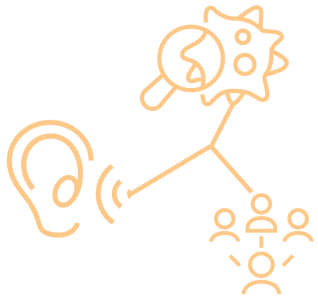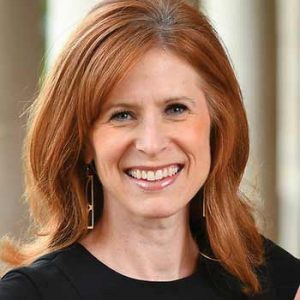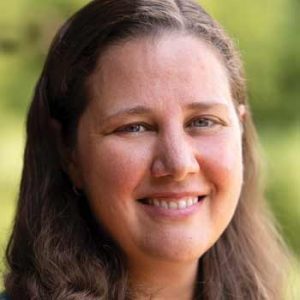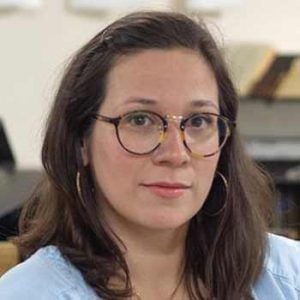On Thursday, March 12, at 12:16 p.m. a single sentence kicked off a massive teaching effort like no other in University of Mississippi history.

“Beginning Monday, March 23, and until further notice, the university will hold all classes and related coursework online or via methods other than in-person, on-campus instruction,” read an email from the Chancellor’s Office.
This missive sent 552 faculty members at the College of Liberal Arts scrambling to teach 4,266 course sections virtually. They improvised classrooms from home offices, kitchen tables, and living rooms, teaching classes varying in size from a one-student voice studio course to a 270-student Anatomy & Physiology lecture. What was it like to turn on a dime and transmogrify in-person to remote teaching? Here is just a small sample.
 Nancy Maria Balach
Nancy Maria Balach
INTERIM CHAIR AND PROFESSOR OF MUSIC
Voice studio, seven sections with one student each
Without the usual live piano accompaniment for students, I had the studio pianists prerecord music for the class. The students had to really listen to the recordings to sing with them. It improved their listening skills. Students exchanged videos of themselves singing, a new addition to the class. The final exam was a live video performance graded by faculty, so this was great practice. So many auditions are done this way now that it’s actually an advantage for students to be comfortable performing on video. We’re going to be doing a lot more of this in the future.
 Mervin Matthew
Mervin Matthew
INSTRUCTIONAL ASSOCIATE PROFESSOR OF PSYCHOLOGY
Introduction to Psychology
Even though I taught a 200-person lecture, I was determined to bring continuity and community to the class and let students know that “we are separate but still together.” I uploaded lectures but made sure they weren’t just straight content delivery. I’d always joked a bit with students before the lecture started, and I continued to do that remotely so that the tone of the class was the same. My biggest concern was students who had no laptops and had to access my prerecorded lectures via cell phone or tablet. To keep them on track, I spoke to many individually on the phone, Facetimed, or Zoomed with them.
 Gavin Davies
Gavin Davies
ASSISTANT PROFESSOR OF PHYSICS
Physics for Science and Engineering
Two other professors and I—Bin Xiao and Jake Bennett—were each teaching three sections of the same class. Mine had 36 students. We had been using a flipped classroom model in the first part of the semester, and we adapted that for virtual learning. Homework was a series of interactive lessons students did before class. I gave a mini lecture on Zoom, and then students worked together in groups of six, using the breakout room function on Zoom. Afterward, they took at-home quizzes on TopHat, an online interface used with a phone or laptop. They had 30 seconds to answer questions with results given in real time. I could tell by the results what concepts had been difficult, and we clarified them before the end of class.
 Gabriel Alexander Garrido
Gabriel Alexander Garrido
INSTRUCTOR OF MODERN LANGUAGES
Intensive Spanish II
My background in engineering served me well, and I developed audio-visual aids for colleagues and our students so they could transition to such a technology-heavy teaching approach. I also created a YouTube channel with segments to help my students with verb forms: subjective, conditional, and future tense. The segments start with Spanish guitar music to get students in the mood to focus on the language. My colleagues were indispensable. As soon as we learned we were teaching remotely, we worked as a team to update our syllabi; and throughout the semester, whether it was 11:45 PM on a Saturday or 7:00 AM on a weekday, we were checking in with each other constantly.
 Susan Allen
Susan Allen
ASSOCIATE PROFESSOR OF POLITICAL SCIENCE
Faces of Poverty
My experiential-learning class focused on studying and creating policies to fight poverty. For the second half of the semester, I’d set up placements at volunteer agencies across the state. Instead of jettisoning the hands-on learning, I asked students to study poverty where they were, in their hometowns. For their final project, my students produced beautiful policy briefs about addressing poverty in their own communities. It was real to them because their work was hitting home.
 Lauren Cardenas
Lauren Cardenas
ASSISTANT PROFESSOR OF ART
Introduction to Intaglio and Silkscreen
Luckily, I’d frontloaded a lot of studio work at the start of the semester. When students were home, I assigned do-it-yourself projects. You use stencils for silkscreen, so students made stencils out of things that they had at hand: wax freezer paper, an embroidery hoop, and a woman’s nylon stocking were some. We also explored contemporary printmakers. I sent links for online exhibits posted by the National Printmakers in New York City. Students studied those and then took technique quizzes.
 Sarah Moses
Sarah Moses
ASSOCIATE PROFESSOR OF RELIGION, DEPARTMENT OF PHILOSOPHY AND RELIGION
Religious Perspectives on Aging and Death; Medical Humanities
Both these classes had a direct and obvious connection to the COVID-19 crisis. I posted a “coronavirus” folder to Blackboard and filled it with news stories about the pandemic. For Medical Humanities, I focused on how this crisis was affecting healthcare professionals and the patient experience of being in the hospital. For the aging class, we focused on the acute crisis the virus was creating in long-term care facilities. It gave my students a very clear sense of how what we were doing in our classes and enabled them to be thoughtful citizens who could analyze current events with a new level of understanding.
 Brian Doctor
Brian Doctor
INSTRUCTIONAL ASSOCIATE PROFESSOR OF BIOLOGY
Intro to Immunology and Serology
I viewed the COVID-19 pandemic as an opportunity to take advantage of the personal interest that the students had in this once-in-a-century (hopefully) pandemic to drive home the core fundamentals in immunology. While we still used our textbooks for the general immune response information, we also read reviews and articles about SARS-COV2. By the end of the semester the students were well versed in the immune response to viruses. Incorporating the current investigations as the story was unfolding before our eyes seemed to markedly increase the breadth and depth of the student’s engagement.